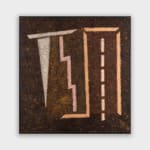

Alejandro Puente Argentina, 1933-2013
Huincul, 1986
Acrylic on canvas
170 x 160 cm
PUA0006
From his first informalist experiences with Grupo Si, Alejandro Puente broke away from the proposals of modern art. While at the beginning he preferred a gesture drawn with strong contrast,...
From his first informalist experiences with Grupo Si, Alejandro Puente broke away from the proposals of modern art. While at the beginning he preferred a gesture drawn with strong contrast, after a brief informalist period, he decided to paint simple shapes with color modulated by the brushstroke. Both his gestural painting and his “sensitive geometry” –as Aldo Pellegrini described it–valued the subject’s imprint against the rationalist distance supported by concrete art programs.In 1965, Puente extended shape and color to the frame in the series of works he exhibited together with César Paternosto at Galería Lirolay. Those paintings adopted the nature of objects and forced the viewer to move, as noticed by Saúl Yurkievich when he pointed out that “they allowed other views, apart from the frontal view.”1. Within this framework, Painting(1965) can be understood as a new breaking point in the classical “Renaissance window”, which had been questioned by concrete artists through its shaped frame proposal.While the structuralist thinking was spreading, Puente created modular works from the notion of system, such as Untitled(1967), made up from four triangular frames. Soon, those modules with color accents on the edges invaded the space, breaking bidimensionality. The notion of system as a whole was essential to his primary structure program –which he exhibited with an information sheet–and his chromatic sequences, such as the one he presented at Information, where his works interacted with the conceptual productions of the international scene.However, at that same time, Puente was making a new turn in his poetics, since, amidst the cultural differences he perceived in the New York scene2, he started to find an air of familiarity among the chromatic systemsoutlined in his information sheets and pre-Hispanic friezes. Immersed in the study of the recurrence of those arrangements in cultural patterns, he took interest in reinterpreting their symbolism, and this decision became the launch pad for the searches he carried out throughout his career. The reflections he shared with Paternosto and Julio Alpuy were deepened when he returned to Argentina as he became in contact with the work and texts of Joaquín Torres García and got close to Libero Badii, with whom he exchanged experiences of culture clash and shared an interest in Americanist iconography.Then, organized compositions began to arise through an homogeneous grid that, as the layout of textiles, contained symbolic borders (Untitleddrawings, 1977 and 1981). In some cases, chromatic sequences adopted an uncu (poncho) format, like Uncu(1973), which, from its very Quechua title, is inspired in the clothes worn by the Incas as a symbol of power and social status

